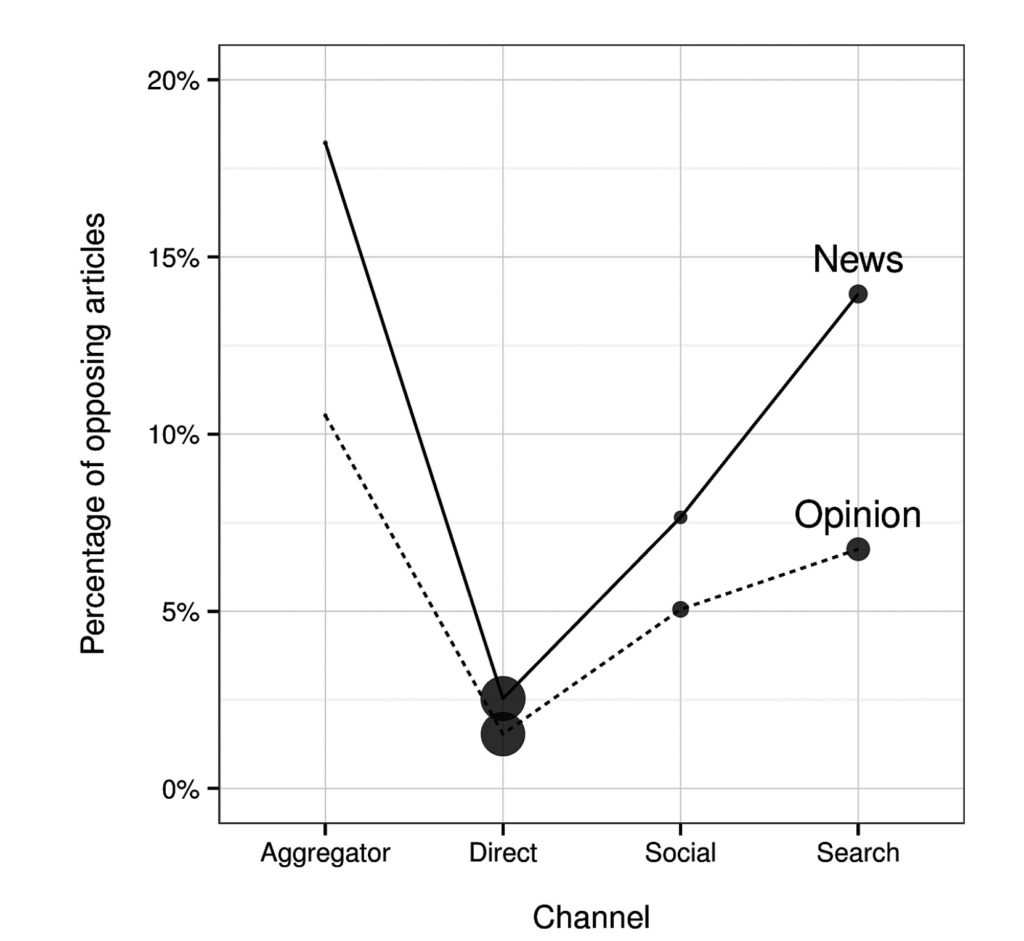I am probably most accurately described as an Internet utopian. When the Internet matured to the point that most folks who were online could not only consume, but also contribute to online discussions, I thought what was called Web 2.0 or the participatory web would engage folks in important issues because they would now have a voice. What occurred was unanticipated and to this point disappointing or at least this is where things seem according to many. Online activity is argued to be secluded in echo chambers and limited by filter bubbles. Rather than expand discussion, present online experiences are described as both more rancorous and narrow. This post is my attempt to outline a quantitative study to evaluate a specific issue bearing on the current state of online affairs. This issue concerns how different channels for access to online news have influenced the breadth of perspectives that are considered.
The study I am attempting to summarize is available using the citation I will add at the end. I admit that some of the analysis was beyond my experience and understanding. The researchers use some statistical methods I did not study.
The researchers had access to online data generated by users who had installed the Bing Toolbar for Internet Explorer and opted in to allow data collection. I am guessing this is a Windows extension for IE and I don’t have enough Windows experience to comment. The willingness of users to share their data must be considered when interpreting the results.
The researches started with data from 1.2 million readers. They set a standard for the number of online news stories and opinion articles from the top 100 news sources they identified of 10 articles and two opinion articles in a three month period to operationalize those who might be described as online news consumers. It made little sense to study the online news reading of individuals who read very little news online. Fourteen percent of the original number met this criterion for news and four percent for both news and opinion articles. This generated a large set of users, but a small proportion of those who generated data.
These data alone are enlightening. It would be difficult to argue that online reading plays a large role in influencing anything because of the small number of individuals meeting these minimum standards. Ten articles in three months? Note as a way to think about this that the New York Times allows users to read 10 articles each month without paying the subscription fee for online access. I reach my limit in most months and get cut off because I do not subscribe to the Times.
My interpretation of the findings is that what we search for and find through social media is likely to be more biased than what we encounter by going directly to news sources. However, of the variable perspectives that we do experience, more of this variability is the result of the use of search and social sources.
How does this make sense, we go to the same direct sources repeatedly. This source will be consistent in orientation. Search and social will be biased by our selection of those we follow and our record of using these services, but offers some chance of a diversity of perspective. Does this have to do with which channel gives us the most control?

These two charts from the study present the data. In this chart, segregation represents how narrow the perspective of readers are who read content from a particular channel. It offers some support for the notion that those who find news articles through search and through social recommendations are getting news sources that are more typically read by those with a narrow view. Note, however that most of what is read (the size of the dots) is dominated by going directly to a news source (e.g., I read the NYTimes which is more liberal, I read content from Fox News which is more conservative). So, the Internet provides access to these sources, but search and social recommendations don’t add much, but what is added tends to be that content read by individuals with a similar view.

However, when viewed articles offering a different point of view are studied, it appears that social and search is most likely to provide that content. What you read directly, is less diverse than what you encounter when you do not directly control access.
What do I think this shows? I think it shows the limitation of self selection. I think it also shows how much influencing personal opinion may come from commentary unlinked to a news source. You can consider my position as you view Facebook or Twitter. How much of what you consume is social commentary only – comments or only the comment when a comment comes with a link to a news source?
Flaxman, S., Goel, S., & Rao, J. M. (2016). Filter bubbles, echo chambers, and online news consumption. Public opinion quarterly, 80(S1), 298-320.
![]()

You must be logged in to post a comment.